‘Majestic, ghostly structures’ to bring part of Hull’s Tudor defences to life
DESIGN: A drawing of the proposed entrance to the South Blockhouse site. Image by Hull City Council / The Manser Practice
By Simon Bristow
Plans to celebrate the history and heritage of Hull’s only scheduled monument, the South Blockhouse, have been revealed.
The proposals will see the site on the east bank of the River Hull completely transformed, with hard and soft landscaping framing the footprint of the South Blockhouse, and “majestic, ghostly structures” rising from the ground to give a sense of the shape and scale of the original building.
The site, close to The Deep visitor attraction, was once part of the city’s Tudor defences, and was uncovered by the largest community archaeology excavation in Hull for 25 years, which took place over 11 weeks earlier this year.
Residents can see the see the plans and give their feedback here.
INSPIRATION: Wire mesh works by Edoardo Tresoldi in Italy, which will inform the South Blockhouse project in Hull. Image by Hull City Council / The Manser Practice
The proposals were made publicly available for the first time on Sunday at a community engagement event at the Fruit Market.
Councillor Paul Drake-Davis, Hull City Council portfolio holder for regeneration, said: “The South Blockhouse captured everyone’s imagination over the summer during the 11-week archaeological dig, exposing the astounding remains of parts of Hull’s Tudor defences.
“The council is really keen to get feedback on these plans on how we celebrate and highlight the site for future generations.”
The South Blockhouse is a Scheduled Ancient Monument of both local and national importance, in a rare cloverleaf design. Its construction was ordered by Henry VIII in 1541 to support military campaigns and to protect Hull as a vital port from internal and external threats, working as one element in a larger scheme of state-of-the art defences on the east side of the river.
SCALE: A drawing showing the proposed layout of the site. Image by Hull City Council / The Manser Practice
The project is linked to Hull Maritime, a locally-led project funded by the council and The National Lottery Heritage Fund, a key cultural regeneration scheme in the heart of the city centre that will protect and celebrate 800 years of Hull’s maritime heritage.
The South Blockhouse project has been made possible by feasibility funding from National Highways, which has Government funding to deliver benefits to communities above and beyond maintaining and operating England’s strategic road network. The project, worth around £1.25m in total, is being put forward for a further £1m in funding for design and delivery.
Frances Oliver, National Highways project manager for the A63 Castle Street scheme, said: “We’re really excited about the South Blockhouse project. It was fascinating to uncover more about this part of Hull’s maritime history during the archaeological digs as part of the A63 Castle Street Project. Now people can find out more about the monument and be part of its future.
“As well as building and maintaining the strategic road network, National Highways is also dedicated to making sure the historic environment and heritage surrounding our roads is protected at every stage through its Designated Funds programme. This is why it’s so important for us to work with our partners and experts to preserve sites of special historic interest.
“We encourage everyone to take a look at the plans and help shape the scheme so this amazing monument can be enjoyed by future generations.”
Further in-person events will follow in the new year, offering more chances for people to have their say on the proposals.



